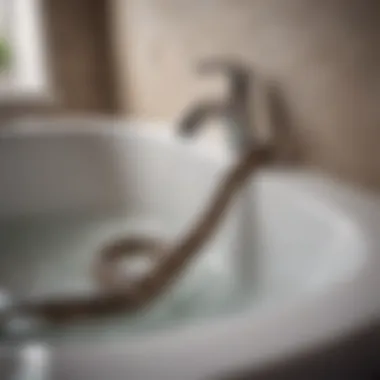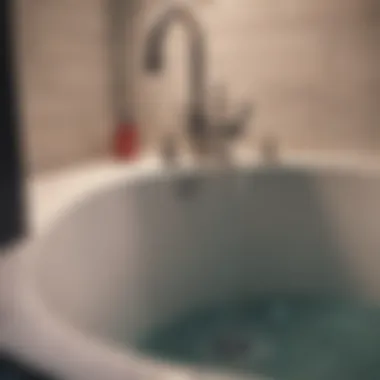Mastering the Art of Snaking Your Bathtub Drain


Intro
In the realm of home maintenance, addressing clogged drains remains an oft-ignored but essential task. The bathtub drain, frequently used yet accidentally overlooked, can quickly become a site of frustration when unduly obstructed. Understanding how to effectively snake out a bathtub drain is crucial for homeowners and DIY enthusiasts alike. This guide unveils practical techniques, offering insights into proper tools, methods, and preventive maintenance that can save both time and effort.
A clogged bathtub drain can lead to more significant plumbing issues if left unattended. This article provides a comprehensive approach, combining both theory and practice to empower readers with knowledge and skills.
Understanding Your Drain
Before diving into the process of snaking out a bathtub drain, it’s important to understand how it functions. The average bathtub drain is designed to handle hair, soap, and other debris. However, over time, these materials can accumulate and create blockages. Knowing the structure of your drain will help in effectively addressing any issues that arise.
- Components of a Bathtub Drain: Understanding the key components, including the drain cover, trap, and waste pipe, is essential.
- Common Causes of Clogs: Recognizing what typically causes blockages aids in prevention and effective removal strategies.
Tools Required
To effectively snake out a bathtub drain, having the right tools is fundamental. Here’s a brief overview of essential items:
- Plumbing Snake: A fundamental tool that helps in dislodging clogs.
- Bucket: To collect any wastewater that may spill during the process.
- Gloves: Protects your hands from dirty water and debris.
- Drain Cleaner: A chemical solution that can aid in breaking down tough clogs.
When preparing to snake out your drain, ensure you have these tools on hand to streamline the process.
Step-By-Step Techniques
- Prepare the Area: Remove any items around the bathtub and place a bucket under the drain to catch any debris.
- Remove the Drain Cover: This can usually be done with a screwdriver or by hand, depending on the design.
- Insert the Plumbing Snake: Insert the end of the snake into the drain and turn the handle to push it further down into the pipe.
- Dislodge the Clog: As you reach resistance, turn the snake to break up the blockage, pulling back to remove any dislodged materials.
- Flush the Drain: Once the blockage is cleared, pour hot water into the drain to wash away residues.
Regular maintenance can significantly reduce the likelihood of clogs, making this process easier.
Safety Precautions
Working with plumbing can come with certain risks. Here are some safety precautions to keep in mind:
- Wear Gloves: Protect your hands from chemicals and debris.
- Use Eye Protection: Ensure that any spray or splatter does not reach your face.
- Be Mindful of Electrical Appliances: Keep electrical devices away from water to avoid hazards.
Maintenance Tips
After successfully snaking a bathtub drain, it is crucial to implement maintenance strategies to prevent future clogs:
- Regular Cleaning: Regularly clean the drain to remove hair and soap residue.
- Use Drain Screens: These can catch hair and larger particles before they enter the drain.
- Avoid Chemical Cleaners: While they can be effective, frequent use may damage pipes over time.
By adhering to these maintenance tips, you can prolong the life of your plumbing system and reduce the frequency of drain issues. With the right knowledge and tools, snaking out a bathtub drain can become a straightforward task, enhancing your understanding of plumbing care.
Preface to Bathtub Drain Issues
Bathtub drain issues are common, yet greatly impact daily comforts. When a drain clogs, it disrupts normal routines and can lead to unsightly messes. Understanding how to address these issues is essential for homeowners and DIY enthusiasts. Climbing into the specifics of bathtub drains can make maintenance less daunting.
Common Causes of Bathtub Clogs
Many factors contribute to bathtub clogs. Hair is the primary culprit, often snagging onto other debris and forming a dense mass. Skin flakes, soap residue, and mineral buildup from hard water can further exacerbate the clogging issues. Regular use often leads to difficult obstructions that don't resolve with simple fixes.
Other less common causes include:
- Accidental foreign object entries, such as toys or toiletries.
- Accumulation of grease or oils that congeal in pipes.
- Structural issues within the plumbing system.
Understanding these causes allows for deeper insight into preventative measures. Keeping a drain free of debris reduces the risk of these futuristic problems.
Understanding Drain Anatomy


Drain anatomy is crucial for effective maintenance and problem-solving. A bathtub drain consists of various components that work together. The primary parts include the drain body, which collects water, and the trap that prevents sewer gases from entering the home. Understanding these components helps identify where blockages can occur.
Critical terms include:
- P-Trap: This curved section below the drain catches debris and holds water, acting as a barrier against odors.
- Overflow Drain: This secondary opening prevents water from overflowing onto the floor.
- Waste Pipe: It carries the waste from the drain to the main plumbing system.
Recognizing each part's role equips individuals with the knowledge needed to address clogs effectively. Knowing how they work together allows for more targeted snaking methods.
Tools Required for Snaking a Drain
Having the right tools is critical when it comes to snaking a bathtub drain effectively. Without the necessary equipment, the process can become frustrating or even ineffective. Proper tools not only make the job simpler but can also prevent potential damage to your plumbing system. Using the wrong or inadequate tools may lead to further complications, which is why it is essential to understand the specific requirements before starting.
Types of Plumbing Snakes
When selecting a plumbing snake, it is important to consider the type that best suits your needs. There are generally two types of plumbing snakes: manual snakes and motorized snakes. Manual snakes require physical effort to operate, making them suitable for lighter clogs or smaller drains. On the other hand, motorized snakes offer more power for tougher clogs. They save time and energy but may be more complex to operate, requiring some familiarity.
1. Manual Drain Snakes:
These are ideal for small blockages. They are portable and easy to store. Manual drain snakes are often made from flexible metal, allowing them to navigate through curves. They are economical and do not require electricity, but may need a bit more effort for stubborn clogs.
2. Motorized Drain Snakes:
These devices are powered by electricity and often come with various attachments. They can handle tough blockages without much manual effort. However, they are heavier and require care in operation to avoid damaging pipes.
Additional Required Tools
While a plumbing snake is essential for clearing the clog, other tools also play a critical role in the process. Here are three additional tools that can enhance your snaking efforts:
Gloves
Using gloves is a fundamental safety precaution when working with drains. They protect your hands from sharp objects and hazardous substances that may accumulate in the pipes. It’s important to choose gloves that are durable and resistant to chemicals. Some popular options are rubber gloves, which offer good dexterity while preventing skin contact with potentially harmful materials.
Bucket
A bucket is useful to catch any water that may spill during the snaking process. As you snake the drain, you might encounter overflow. The bucket will help keep your work area clean. It provides a simple way to handle any mess. Furthermore, having a dedicated bucket can make the cleanup much easier after servicing the drain.
Wrench
A wrench is used to remove the drain cover and other fittings. It allows you to apply the necessary torque without risking damage. It can prove to be particularly useful if fittings are rusted or difficult to turn by hand. Make sure to select an adjustable wrench for versatility, or a socket wrench if you need some precision. The right wrench can save time and effort in unscrewing components, making the process smoother.
Upon assembling your tools, you can proceed with confidence to tackle bathtub drain clogs effectively.
Preparing for the Snaking Process
Before you begin using a plumbing snake on a bathtub drain, preparing for the snaking process is essential. This stage lays the foundation for an effective unclogging operation. It’s more than just grabbing tools and starting the process. A systematic approach minimizes the chances of additional complications and maximizes efficiency.
Key elements of preparation include clearing the area and ensuring safety during the entire procedure. The benefits are significant. By organizing your space and gathering all necessary items, you minimize disruptions and stay focused on the task. This preparation stage also helps create a safe environment, reducing the risk of accidents and injuries.
You should not rush into snaking a drain without these considerations. Preparation ensures that when you do begin, you can execute the procedure smoothly and successfully.
Clearing the Area
Clearing the area around your bathtub is a vital first step. This involves removing any items that could interfere with your work, such as bath mats, toiletries, or other belongings. A clutter-free space allows for easy access to the drain and prevents any obstacles that might hinder your progress.
To clear the area, consider these actions:
- Move bath products and decorations out of the way.
- Ensure the floor is clean to prevent slipping.
- Have your tools organized and within reach.
This approach not only enhances efficiency but also ensures you can focus entirely on the task. It is crucial to avoid accidents that can arise from a messy workspace.


Safety Precautions to Consider
Safety should always be a priority when addressing plumbing issues. Before starting, keep these safety precautions in mind:
- Wear gloves: Protect your hands from bacteria and debris that can be present in drains.
- Use goggles: To shield your eyes from splashes and debris.
- Unplug appliances: Ensure no electronic devices or appliances are in the vicinity of water.
- Use proper lifting techniques: If you need to move heavy items.
"Preparation is key to safety and efficiency in any DIY project, particularly in plumbing."
By following these safety measures, you minimize the risk of injuries and create an environment conducive to focusing on the task at hand. With everything set, you are now ready to proceed with the snaking process, equipped with both efficiency and safety in mind.
Step-by-Step Guide to Snaking a Bathtub Drain
Snaking a bathtub drain is a practical approach to resolving clogs that can impede the proper flow of water. Understanding the step-by-step process is crucial to ensure effectiveness and prevent damage to the plumbing system. Mastery of this technique also allows homeowners and DIY enthusiasts to handle issues independently, saving time and money, while fostering a sense of accomplishment. With clear instructions and the right tools, even a novice can manage the snaking process efficiently.
Removing the Drain Cover
The initial step in this process is to remove the drain cover, which is often secured with screws or clips. It is essential to have a screwdriver and a bucket ready, as water may have accumulated in the drain. Carefully use the screwdriver to loosen the screws. If the drain cover is stuck, a gentle twist may help dislodge it. Once removed, set the cover aside in a safe place to prevent any loss or misplacement during the procedure.
Inserting the Plumbing Snake
Once the drain cover is off, the next step is to insert the plumbing snake into the drain. The plumbing snake is designed to reach deep into the plumbing, effectively dislodging clogs. Begin by feeding the snake gently into the pipe. It's important not to force it, as excessive pressure can damage the pipes. You should feel some resistance as the snake encounters clogs. Keep a steady hand and guide it slowly into the drain until you cannot push it further.
Navigating Through the Drain
After inserting the plumbing snake, the next phase is navigating through the drain system. This requires patience and a bit of technique. As you twist the snake in a clockwise motion, it will enable movement through the bends and turns of the plumbing. Should you encounter resistance, continue applying gentle pressure while keeping the twisting motion. This allows the snake to do its job without risking any significant damage to the pipes.
Retrieving Debris
After successfully navigating through the drain and breaking apart the clog, it is imperative to retrieve any debris that the snake may have loosened.
Checking for Obstructions
Checking for obstructions is a vital part of the process, ensuring that no residue is left behind in the pipes. This aspect significantly contributes to overall drain health. By effectively identifying remaining clogs or debris, you can prevent future plumbing issues. The key characteristic of this step is its focus on thoroughness, which is crucial in achieving a more permanent solution. This method allows for an in-depth inspection of the drain, ensuring that no further blockages are present. Therefore, it is a beneficial choice to include this check in your routine.
Clearing Clogs
Clearing clogs is this step’s main goal and function. Once you retrieve debris, ensure to clear any remaining clogs for excellent water flow. This action directly influences the effectiveness of the snaking process. The unique feature of this step lies in its ability to resolve issues that commonly lead to repeated clogs, thus extending the time before the next maintenance is needed. It’s essential to handle this part thoroughly to maintain efficient drainage in the bathtub.
Aftercare Following Snaking
Aftercare following the snaking of a bathtub drain is a crucial element in ensuring that the work done has effectively resolved the clogging issue. Many homeowners may think that once they have successfully removed the debris and water flows freely, the task is complete. However, neglecting aftercare can lead to recurring problems, causing unnecessary frustration and additional expenses in the future. Addressing the aftercare steps can help in maintaining optimal drain function and preventing future clogs.
Reassembling the Drain Cover
Once the snaking process is complete and you have retrieved all debris from the drain, the next step is to reassemble the drain cover. This ensures that your drain remains protected from future obstructions. Start by ensuring that the drain cover is clean. Any residue or debris left behind can contribute to future clogs. Place the cover back onto its original position, ensuring all screw holes align correctly. Secure the cover using the screws or clips provided. Be careful not to overtighten screws as this could damage the fittings or create a seal that is too tight, leading to other issues. A well-fitted drain cover not only prevents foreign objects from entering the drain but also enhances the overall aesthetic of your bathtub.
Testing the Drain Flow
After reassembling the drain cover, it is essential to test the drain flow. Turn on the bathtub faucet and allow water to run for a few minutes. Observe how quickly the water drains. Ideally, it should flow without any slowdowns or backups. Any lingering water, or signs of reduced flow, may indicate that there is still some debris left in the system or that another clog is forming.
This step serves as a confirmatory measure for the work done. If you notice issues during testing, further action will be needed. It could be beneficial to consider the use of a bio-friendly cleaner that helps maintain drain hygiene without causing harm to the plumbing system.
"Regular monitoring of drain flow after maintenance can prevent most clogging issues before they arise."
Troubleshooting Common Problems


When snaking out a bathtub drain, sometimes issues occur that demand immediate attention. Understanding the common problems that can arise is essential for successful maintenance. This section outlines key challenges and offers solutions for persistent clogs and alternative methods of addressing stubborn blockages.
Persistent Clogs
Persistent clogs often signal deeper issues within the plumbing system. These clogs do not respond to basic snaking techniques and can be frustrating for homeowners. Recognizing the signs of a persistent clog is the first step. Look for slow drainage, unpleasant odors, or reactions to other plumbing fixtures, such as water backing up into the tub.
In cases of persistent clogs, the use of a plumbing snake might need to be adjusted. You may have to use a more mechanical approach, such as an auger with a corkscrew design that can grip and remove debris more effectively. Additionally, consider inspecting the P-trap, as it can accumulate debris that leads to recurring clogs.
Regular maintenance, including routine snaking and hot water flushing, can minimize the development of this type of problem. It is crucial to be patient and precise during the snaking process to avoid damaging the pipes.
Using Alternative Methods
Sometimes, conventional snaking methods may not suffice. In these situations, alternative methods become relevant and may offer effective solutions to stubborn clogs. Two primary alternative approaches include the use of chemical drain cleaners and professional services.
Chemical Drain Cleaners
Chemical drain cleaners provide a quick solution to clogged drains. These products typically contain strong chemicals, designed to dissolve hair, grease, and soap scum. A key characteristic of chemical drain cleaners is their speed. They often act fast, providing an almost immediate effect when dealing with minor clogs.
However, the unique feature of most chemical drain cleaners is their potential harm to pipes. Overuse can lead to corrosion, which eventually might compromise pipe integrity. Homeowners should weigh these advantages against the disadvantages carefully. Using these cleaners occasionally can be a beneficial choice, while consistent use may result in more plumbing issues down the line.
Professional Services
Engaging professional plumbing services is sometimes necessary when home methods fail. The key characteristic of professional services is their expertise and advanced tools. Plumbers can diagnose the underlying issues causing persistent clogs effectively using specialized equipment like cameras and high-pressure water jets.
One unique feature of professional plumbing services is their guarantee. Often, they provide solutions with a warranty, giving homeowners peace of mind. However, the primary disadvantage is cost; hiring professionals can be expensive compared to DIY methods.
Key Takeaway: It’s important to assess the severity of the clog and the condition of your plumbing before deciding on a method. Each option has its pros and cons, making careful consideration essential for effective drain maintenance.
Preventive Maintenance Tips
Preventive maintenance is crucial for maintaining the function and longevity of your bathtub drain. By proactively addressing potential issues before they escalate, you can avoid costly repairs and ensure a smooth draining process. A few key reasons for focusing on preventive maintenance include reducing the likelihood of clogs, extending the life of your plumbing systems, and enhancing overall home hygiene.
Regular Drain Cleaning Techniques
Regular drain cleaning is a fundamental practice in preventive maintenance. It helps to remove build-up and debris that can lead to clogs over time. Here are some effective techniques:
- Hot Water Flush: Pouring boiling water down the drain can help dissolve any soap scum or grease buildup. This method is simple and effective when done regularly.
- Natural Cleaners: A mixture of baking soda and vinegar can break down many materials causing slow drains. After pouring in the baking soda, follow it with vinegar, let it fizz, then flush with hot water.
- Professional Cleaning: Consider having a plumber perform a thorough cleaning annually, especially if you notice recurring issues.
These techniques can be easily integrated into a home maintenance schedule, providing long-term benefits and preventing unexpected blockages.
Monitoring Drain Health
Monitoring the health of your drain is an essential part of preventive maintenance. Observing for signs of trouble early can save you from extensive repairs later. Here are some considerations to keep in mind:
- Listen for Unusual Sounds: Gurgling or bubbling noises can indicate blockages forming, suggesting that immediate action may be necessary.
- Track Water Flow: Notice if water starts to drain slower than usual. This can be an early warning sign of a clog.
- Regular Inspections: Check the drain cover area periodically for leaks or moisture buildup, which might suggest water pooling.
Preventive measures such as these foster a proactive approach to plumbing care. Recognizing these signals early can significantly mitigate larger plumbing issues in the future, ensuring a more efficient and healthier home environment.
Regular maintenance and observation can prevent larger problems, saving time and expenses.
By integrating these preventive measures into your routine, you greatly enhance the performance and durability of your bathtub drain.
Culmination
The conclusion serves as a critical synthesis of the information provided throughout this article on snaking out a bathtub drain. It encapsulates the essential techniques, tools, and preventive measures that are vital for maintaining a functional plumbing system in any home. Understanding how to properly snake out a drain not only resolves immediate clogging issues but also empowers homeowners and DIY enthusiasts with the knowledge to tackle similar problems in the future.
One of the primary benefits discussed is the enhanced ability to manage and prevent clogs through regular maintenance. Regularly applying the techniques outlined can lead to prolonged lifespan of the drains and reduce the frequency of emergency interventions. Also, learning the anatomy of your drain—as was detailed in earlier sections—can illuminate potential trouble spots that may need extra attention.
Furthermore, utilizing the right tools and safety precautions is crucial. Equipping oneself with basic plumbing knowledge and practical skills can help avoid costly repairs and the need for professional services. Therefore, as a homeowner, taking the time to familiarize oneself with these techniques creates long-term value.
In closing, having a thorough understanding of effective drain care consolidates one's capability to handle household maintenance proactively. The integration of the step-by-step guide with preventive tips offers a roadmap to not only solve current issues but to foster a proactive attitude toward plumbing health. This empowers readers not only to resolve the issue at hand but to foster an ongoing effort in maintaining their household infrastructure. Together, these elements reflect the intertwining of knowledge and practice, reinforcing the importance of effective plumbing care.















